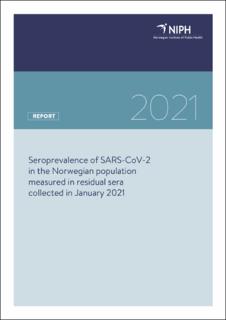| dc.contributor.author | Tunheim, Gro | |
| dc.contributor.author | Kran, Anne-Marte Bakken | |
| dc.contributor.author | Rø, Gunnar Øyvind Isaksson | |
| dc.contributor.author | Hungnes, Olav | |
| dc.contributor.author | Lund-Johansen, Fridtjof | |
| dc.contributor.author | Vaage, Eline Benno | |
| dc.contributor.author | Tran, Trung | |
| dc.contributor.author | Andersen, Jan | |
| dc.contributor.author | Vaage, John T. | |
| dc.date.accessioned | 2021-12-10T07:16:42Z | |
| dc.date.available | 2021-12-10T07:16:42Z | |
| dc.date.created | 2021-12-08T09:56:37Z | |
| dc.date.issued | 2021 | |
| dc.identifier.isbn | 978-82-8406-182-5 | |
| dc.identifier.uri | https://hdl.handle.net/11250/2833660 | |
| dc.description.abstract | COVID-19 is an infectious disease caused by the novel coronavirus SARS-CoV-2. Infection with SARS-CoV-2 induces antibodies to the virus, therefore, in the absence of vaccination, the presence of SARS-CoV-2 specific antibodies in a person’s blood indicates that the person has been infected with SARS-CoV-2. This is the third study measuring antibodies against SARS-CoV-2 in residual serum samples collected systematically from various geographical regions in Norway and covering all age groups. The first study with residual sera collected in April/May 2020 and August 2019, was published as a report in June 2020 (1). The second study, with residual sera collected in the late summer of 2020, was published as a report in December 2020 (2). In the present study, data on the seroprevalence in Norway in January 2021, at the end of the second wave of the pandemic, is presented. A total of 1912 residual sera were sampled from 17 microbiology laboratories in January 2020 (week number 53 in 2020/2021 to week number 6, 2021). Most of the samples (85.7%) were collected between week numbers 1-3, 2021. The sera were tested for antibodies against SARS-CoV-2 using an in-house assay established at the Department of Immunology, Oslo University Hospital. Based on these measurements, the estimated seroprevalence in the Norwegian population in January 2021 was 3.2% (95% credible interval (CrI) 2.3 - 4.1). This is an increase from the seroprevalence estimate in the late summer of 2020 (0.6% (95% CrI 0.2- 1.2))(2). Antibodies against SARS-CoV-2 were found in a total of 61 of the 1912 samples and were detected in samples from 10 of the 11 Norwegian counties. There were no significant differences between the seroprevalence estimates for each county. However, the number of samples from each county varied considerably. There were no significant differences between the seroprevalence estimates for the various age groups or between males and females. | en |
| dc.description.abstract | Norsk sammendrag
Covid-19 er en infeksjonssykdom som skyldes det nye koronaviruset SARS-CoV-2. Infeksjon med SARS-CoV-2 induserer antistoffer mot viruset, og funn av virusspesifikke antistoffer i blodprøver fra uvaksinerte indikerer gjennomgått infeksjon. Dette er den tredje studien som måler antistoffer mot SARS-CoV-2 i serumprøver som er systematisk samlet inn fra ulike geografiske områder i Norge, og som representerer alle aldersgrupper. Den første studien, basert på restsera samlet inn i april/mai 2020 og august 2019, ble publisert som en rapport i juni 2020 (1). Den andre studien, basert på restsera samlet inn på sensommeren 2020, ble publisert som en rapport i desember 2020 (2). I denne studien, ble til sammen 1912 restsera samlet inn i løpet av januar 2021 (uke 53-6) fra 17 laboratorier. De fleste prøvene (85,7 %) ble samlet inn mellom uke 1-3. Serumprøvene ble testet for antistoffer mot SARS-CoV-2 med en metode som er utviklet og etablert ved Avdeling for immunologi og transfusjonsmedisin ved Oslo universitetssykehus. Ut ifra disse målingene lå den estimerte andelen av den norske befolkningen som har antistoffer mot SARS-CoV-2 (seroprevalensen) på 3,2 % (95 % kredibilitetsintervall 2,3 – 4,1) i denne perioden. Dette er høyere enn den estimerte seroprevalensen sensommeren 2020 (0,6 % (95 % kredibilitetsintervall 0,2 – 1,2)) (2). Antistoffer mot SARS-CoV-2 ble funnet i totalt 61 prøver. De positive prøvene var fra personer bosatt i 10 av de 11 norske fylkene, men det var ingen signifikante forskjeller i estimert seroprevalens mellom de ulike fylkene. Imidlertid var det stor variasjon i antall prøver fra hvert fylke. Det ble ikke funnet noen signifikante forskjeller i estimert seroprevalens mellom ulike aldersgrupper eller mellom ulike kjønn. | no |
| dc.language.iso | eng | |
| dc.publisher | Norwegian Institute of Public Health, Division of Infection Control and Environmental Health | |
| dc.relation.uri | https://www.fhi.no/globalassets/dokumenterfiler/rapporter/2021/seroprevalence-of-sars-cov-2.pdf | |
| dc.subject.mesh | Covid-19 | en |
| dc.subject.mesh | Communicable Diseases | en |
| dc.subject.mesh | COVID-19 Serological Testing | en |
| dc.subject.mesh | SARS-CoV-2 | en |
| dc.subject.mesh | Seroepidemiologic Studies | en |
| dc.subject.mesh | Diagnostic Tests, Routine | en |
| dc.subject.mesh | Norway | en |
| dc.subject.mesh | Sarsvirus | no |
| dc.subject.mesh | Sars-coronavirus | no |
| dc.subject.mesh | Diagnostiske tester | no |
| dc.subject.mesh | Seroprevalens | no |
| dc.subject.mesh | Smittesporing | no |
| dc.subject.mesh | Smittsomme sykdommer | no |
| dc.subject.mesh | Norge | no |
| dc.title | Seroprevalence of SARS-CoV-2 in the Norwegian population measured in residual sera collected in January 2021 | |
| dc.title.alternative | Seroprevalence of SARS-CoV-2 in the Norwegian population measured in residual sera collected in January 2021 | |
| dc.type | Research report | |
| dc.description.version | publishedVersion | |
| dc.source.pagenumber | 16 | |
| dc.identifier.cristin | 1965973 | |
| cristin.ispublished | true | |
| cristin.fulltext | original | |
